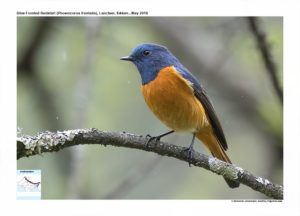Blue-fronted Redstart

Blue-fronted Redstart Phoenicurus frontalis
Etymology:
- Phoenicurus : Greek word phoinix –crimson, red, purple; ouros –tailed
- Frontalis : Latin word for “fronted” derived from frontis – forehead, front.
Vernacular Names : Lepcha: Tak-tirriri-pho
Distribution in India: Summer visitor in Upper Himalayas and migrates down to valleys in winter.
Description: Size of 15-16 cm. This the only Redstart with inverted-T pattern on tail. The breeding male has blue head, back, wings and throat; rest of underparts, rump and relatively long tail rufous-orange, tail with black central feathers and distal third; bill and legs black. The non-breeding male is heavily scaled buff above. The female is dull greyish-brown, tail as male. The juvenile is dark brown with buff spotting, buffy on belly, tail as male.
Habitat: It is found in dwarf juniper, rhododendron, birch scrub and open grassy areas. Winters in understorey of open forest, bushy river valleys , gorges, and in open terrain with bushes, cultivated clearings, tea gardens, terraces, pastures, scrub, thickets, etc., at 1000–2700 m.
Food Habits: It eats Insects, berries, seeds. Insects predominate May–Sept, but from Aug berries and seeds also taken; in winter exclusively vegetable material, Caterpillars fed to nestlings. It forages by making short flights from perch; also occasionally hawks flying insects
Breeding Habits: They breed in May-Aug.Nest a cup of dry moss bedded on coarse grass, lined with hair, feathers or thin roots, placed in tree hole, stump, wall crevice, end of fallen tree, crack in rock face, among rocks or under dense vegetation. They lay a clutch of 3–6 eggs. Incubation period is 12 days; nestling period 12–17 days, but young often flightless for several days after leaving nest; post-fledging dependence as short as 12 days. The nest is parasitized by Common Cuckoo.